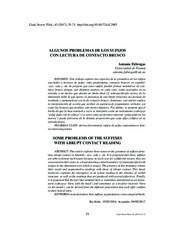Algunos problemas de los sufijos con lectura de contacto brusco
Permanent link
https://hdl.handle.net/10037/13965Date
2017-05-09Type
Journal articleTidsskriftartikkel
Peer reviewed
Author
Fábregas, AntonioAbstract
RESUMEN: Este trabajo explora tres aspectos de la gramática de los sufijos asociados a lecturas de golpe – más propiamente, contacto brusco- en español: -aco, -ada y –ón. Se propone que estos sufijos pueden formar sustantivos de contacto brusco porque, por distintos motivos en cada caso, están asociados en su entrada a un núcleo que denota un límite final (]) subespecificado acerca de la dimensión sobre la que opera; la presencia de este limite relaciona sus lecturas de resultado y aumentativas con la de contacto brusco. Asimismo, este núcleo explica la interpretación de acción que reciben en ausencia de propiedades verbales, así como las lecturas que produce con ciertos adjetivos. Por último, se propone que el heco de que la base nominal a veces se iterprete como un istrumento (caberzazo ‘golpe dado con la cabeza’) y a veces como un locativo (morrón ‘golpe dado en los morros’) puede derivarse de la distina preposición que cada afijo codifica en su entrada léxica. ABSTRACT: This article expores three issues in the grammar of suffixes denoting abrupt contact in Spanic: -azo, -ada y –ón. It is proposed that these suffixes are able to denote such nouns because, in each case for a different reason, they are associated in their entry to a head denoting a final boundary (]) underspecified with respect to the dimension over which it ranges. The presence of this boundary relates their result and augmentative readings with those of abrupt contact. This head, moreover, explains the emergence of an action reading in the absence of verbal structure, as well as the readings that are produced with several adjectives. Finally, it is proposed that the fact that nominal base is sometimes interpreted as an instrument (cabezazo ‘blow with the head’) and sometimes as a locative (morrón ‘blow on the mouth’) can be derived from the different preposion that each affix codifies in their lexical entry.
Description
Source at http://dx.doi.org/10.18172/cif.2985.


 English
English norsk
norsk